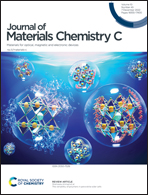Molecular engineering of ruthenium(ii) complexes with (3-polyamino)phenanthroline ligands for developing reusable optical sensors for Cu(ii) ions†
Abstract
This work is aimed at the development of synthetic approaches to luminescent hybrid organic–inorganic materials based on chemosensors bearing phosphonate anchoring groups for the detection of toxic metal ions in aqueous solutions. To that end, the sensing properties of phosphonate-substituted ruthenium(II) complex with (3-polyamino)phenanthroline Ru(N3P3phen) toward toxic metal ions in aqueous media at physiological pH was investigated and compared to those of the known selective chemosensor Ru(N2P2phen) for copper(II) ions. The Ru(N3P3phen) complex enables us to detect copper(II) by luminescence measurements and is much more sensitive (limit of detection (LOD) is 0.02 μM) than Ru(N2P2phen). The main advantage of the chemosensors Ru(N2P2phen) and Ru(N3P3phen) studied herein is the possibility to immobilize them on titanium oxide surfaces without extra-synthetic costs using phosphonate substituents as anchoring groups. After activation with TMSBr, both complexes were successfully grafted on hydrated mesoporous TiO2 (SBET = 650 m2 g−1) performing reactions in DMF solutions at room temperature. Strong covalent binding of chemosensors Ru(N2P2phen) and Ru(N3P3phen) to the mesoporous TiO2 support provides high chemical stability to the functionalized solids Ru(N2P2phen)@TiO2 and Ru(N3P3phen)@TiO2 but only one of them gives an optical response in the presence of copper(II) ions. The Ru(N3P3phen)@TiO2 material thus prepared allows for the luminescent detection of cupric ions in aqueous solutions displaying LOD lower than 10−13 M. Such a high sensitivity is unprecedented and cannot be obtained using soluble chemosensors in solutions. This solid-state sensor can be regenerated and reused at least three times.



 Please wait while we load your content...
Please wait while we load your content...